Purebreed Sleddogs
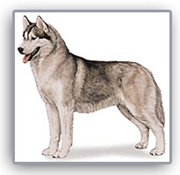 |
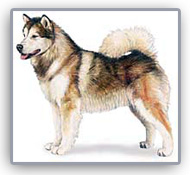 |
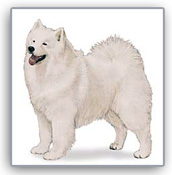 |
| Siberian Husky | Alaskan Malamute | Samoyed |
 |
||
| Greenland Dog |

"The Siberian Husky is one of the most ancient and noble of all purebred dogs, but he is not the ideal pet for every family. His sled dog heritage provides him with an innate desire tor un, a very high energy level, and a degree of independence that is sometimes maddening. He typically does not come when he is called, he loves to dig holes, and he sheds his profuse coat once or twice a year by the bushel basketful. He is also an escape artist of Houdini - like abilities and absolutely requires a very secure fenced in yard or pen, preferably both. He also typically loves everyone, including any potencial buglar, thereby rendering him a "hopeless case" as a reliable guard dog."*
"On the other hand, the Siberian Husky is remarkably intelligente, clownish and charming. He loves children and is extremly sweet and gentle with them. He is extremly clean and odorless, making him an excellent choice as a companion for those with any tendency to dog - related allergies."*
"Although this multy-talented dog was assiginally bred principally as a sled dog, it currently performs many other roles in modern society. Besides beeing a wonderful family pet, he also serves as an active companion in a variety of outdoor sports and activities. Siberians are great jogging partners, willing tor un as far as you can."**
* Michale Jennings: The Siberian Husky, ** Kathleen Kanzler: A New Owner's Guide to the Siberian Husky
Siberian Huskies are still used as sled dogs in sled dog racing. Siberians are still popular in races restricted to purebreds and are faster than other pure sled-dog breeds such as the Samoyed and the slower but much stronger Alaskan Malamute. Today the breed tends to divide along lines of "racing" Siberians and "show" Siberians. Racing Siberians tend to have more leg to enable them more reach when running. Show Siberians tend to be a bit smaller.
Apart from sled racing, they are very popular for recreational mushing and are also used for skijoring (one to three dogs pulling a skier) and European ski-hi. A few owners use them for dog-packing and hiking.
Link to the Standard: HERE
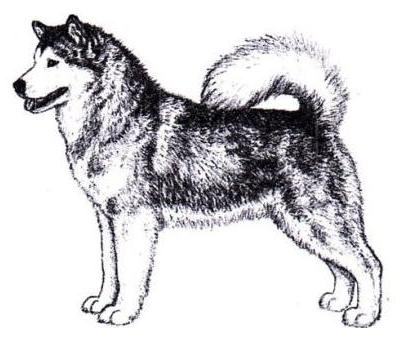
Alaskan Malamutes are still in use as sled dogs for personal travel, hauling freight, or helping move light objects; some however are used for the recreational pursuit of sledding, also known as mushing, as well as for skijoring, bikejoring, carting, and canicross. However, most Malamutes today are kept as family pets or as show or performance dogs in weight pulling, dog agility, or packing. Malamutes are generally slower in long-distance dogsled racing against smaller and faster breeds and their working usefulness is limited to freighting or traveling over long distances at a far slower rate than that required for racing. They can also help move heavy objects over shorter distances.They are also very smart animals, though they can be hard to train.
The Malamute retains more of its original form and function than many other modern breeds. The Malamute personality is one of strong independence. If a dog owner cannot cope with a dog that will not comply with the owner's every command, a more compliant breed should be selected. This dog has a long genetic foundation of living in the harshest environment imaginable, and many of its behaviors are evolved to survive in such environments. Independence, resourcefulness, and natural behaviors are common in the breed. Because of their intelligence, they can be difficult dogs to train. However, if the trainer understands Malamutes and how to keep them motivated, success is possible.
Malamutes are quite fond of people, a trait that makes them particularly sought-after family dogs but unreliable watchdogs. Malamutes are nimble around furniture and smaller items, making them ideal house dogs, provided they get plenty of time outdoors meeting their considerable exercise requirements. If they are year-round outdoor dogs, letting them play in a baby pool filled with cold water in summer keeps them cool. In the winter, they love snow.
Malamutes are usually quiet dogs, seldom barking. When a Malamute does vocalize, it often appears to be "talking" by vocalizing a "woo woo" sound. It may howl like a wolf or coyote, and for the same reason.
Link to the Standard: HERE
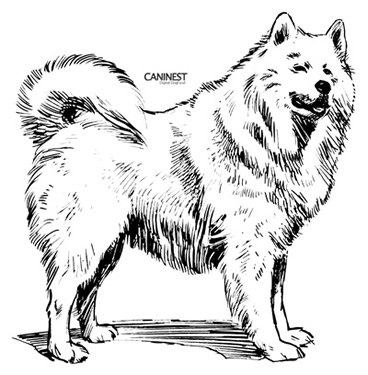
A hardy and eager worker, the Samoyed is known for black lips that curl slightly at the corners into the "Samoyed smile." Bright and alert, he likes to stay busy and enjoys participating in agility, herding, weight pulling, sledding, pack hiking, conformation shows and more! His heavy, weather resistant coat is suitable for very cold climates and should be pure white, white and biscuit, cream or biscuit.
Intelligent, gentle and loyal, Samoyeds enjoy being with their families. Due to their working heritage, they may chase things, run and bark, so it's best to channel that energy into some kind of job or activity. Otherwise, these independent thinkers may invent ways to keep themselves entertained. At the very least, daily exercise is necessary. The Samoyed coat can also mat and needs to be brushed weekly, more often during shedding season.
Link to the Standard: HERE
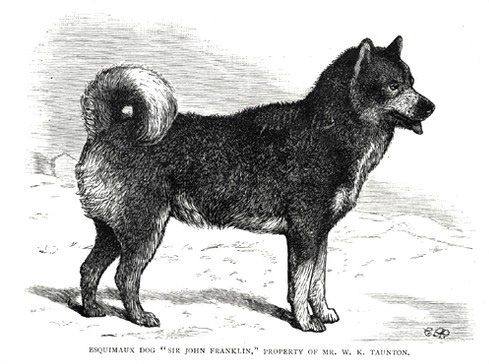
The Greenland Dog (Danish: Grønlandshunden, also known as Greenland Husky) is a large breed of husky-type dog kept as a sled dog and for hunting polar bear and seal. This is an ancient breed, thought to be directly descended from dogs brought to Greenland by the first Inuit settlers.
In Greenland this breed exists in much the same condition as it had when originally arriving there, and is kept as chiefly as a working dog valued for its strength and speed rather than a malleable temperament. As a result of living in a pack structure very much similar to their wolf forebears, the Greenland dog takes a very firm and confident owner to make a good pet.[not in citation given Once one has won their respect, however, they can be very loyal and protective of their owners, especially if in a pack.
As is common among sled dogs, Greenland Dogs are able to traverse very difficult terrain with ease and with a high tempo. As working dogs they are especially valued for their physical strength and endurance.
Link to the Standard: HERE
